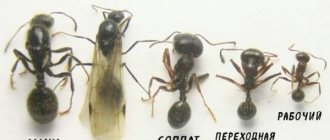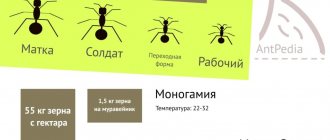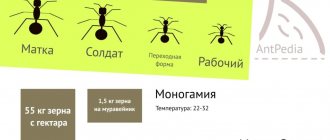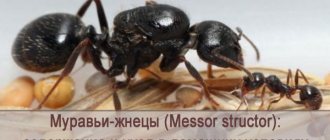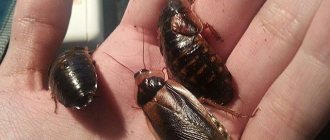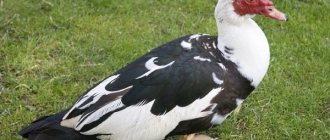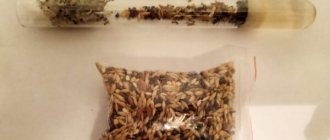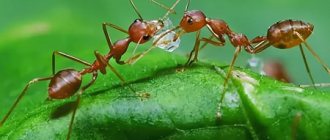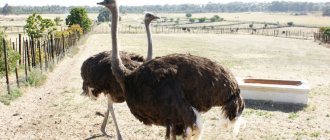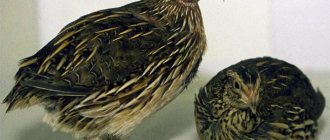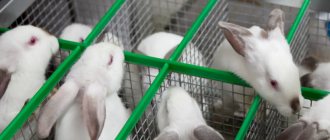Ants are colonial animals with a strict colony organization that varies among species. A colony usually consists of one or more egg-laying individuals - queens - and workers. In some species, workers can be divided into castes - small, medium, large workers and soldiers. This polymorphism of workers is characteristic, for example, of reapers.
The life cycle of ants begins with an egg laid by the queen. It has a spherical shape; Usually the eggs stick together to form a “package” and are carried in this form by workers. After a few days, the egg hatches into a larva. By themselves, the reaper larvae are not able to move or feed independently and have a cone-shaped shape with a curved upper part. The workers feed the larvae. In the case of harvester ants, the main food is flour obtained by grinding plant seeds. As the larva grows, it increases significantly in size and, depending on conditions, pupates in 1-2 months. Reaper pupae do not have cocoons, so you can follow how the metamorphosis into a full-fledged ant occurs. At the last stage of development, the pupae darken and begin to move.
Briefly about the family characteristics of ants
Ant families are made up of millions of insects. Each representative has his own responsibilities, and there is a division of labor in clans. A parallel can be drawn with human life. This was the reason that scientists carefully studied the ant family.
Ant queen
Every ant family has a queen. In other words, she can be called a reproductive female. It is acceptable for one clan to have several such females. This female is the queen and is responsible for laying eggs.
Externally, the queen ant looks like a working insect. A distinctive feature is its large size. The female has wings, up to a certain point. After fertilization has occurred, she bites off her wings on her own.
The queen mates only once during her entire life. The male's seminal fluid remains in the female. Sperm consumption occurs evenly.
Queen ants of some species can leave the nest and search for food.
Males
Males have wings, but there are exceptions. One clan (Cardiocondyla) contains wingless insects. Even in the nest where they appeared, they have a competitive struggle among themselves. They fight for young females. Most of the males die during the fight.
In the ant family, the role of males is small. They are necessary only to fertilize the uterus. They may appear in the nest several hours before the mating flight.
After mating has occurred, the males die.
Worker ants
The main part of the ant family is made up of workers. These are females that cannot reproduce. They do not have a developed reproductive system.
The main task of worker ants is to take care of all members of the clan.
Distinctive features:
- the workers have no wings;
- the chest is poorly developed;
- the eyes are either small or absent at all.
Such ants are especially active, hardy, and their organs are very susceptible.
Choosing an ant farm
You can buy an ant farm with insects in stores that sell pet supplies, or order it online. When choosing a farm, it is important to consider the following nuances:
Safety
There should be no sharp corners or objects inside or outside the anthill that could injure insects or their observers.
Convenience
Choose a formicarium that is spacious and transparent, filled with sand and equipped with a ventilation system.
Environmental friendliness
Give preference to containers made from non-toxic materials.
Genetics
After conducting genetic studies of ants, scientists concluded that insect genes contain more than 600 individual DNA sections. Most of them are responsible for social behavior. A gene has also been found that is responsible for how many females will live in the clan. Those. only born ants know what their duties are.
Typically, the gene pool is subject to mixing. One exception is the cloning process. It happens in nature that in fertilized eggs all the mother’s chromosomes are destroyed and, as a result, males appear.
What is this
An ant formicarium is an anthill made by human hands.
The first man-made anthills were built by scientists back in the 19th century for scientific observations. Over time, thanks to popular naturalists, the social behavior of ants became of interest to people far from science, and as a result, the simplest designs of home anthills began to appear.
Did you know? The famous French writer Bernard Verber wrote three science fiction novels about ants in 1991-1995: “Ants”, “Day of the Ant”, “Revolution of the Ants”, which are still bestsellers.
The first formicarium was patented in 1931 by Frank Austin , a research professor at the Thayer School of Engineering at Dartmouth College. Since then, ant farms have been sold all over the world and even sent cash on delivery, such as Uncle Milton's Ant Farm. About 20,000,000 educational “toys” under this brand have been sold.
Ways to create a family
Ants breed only once a year. Only some species are capable of producing offspring twice a year. Insects do not have a standard reproduction process. Conception can occur in different ways.
Independent
At the start of the mating flight, the queens leave their homes. Next, the reproduction process looks like this:
- Not far from the exit they are met by males ready for fertilization. Their main task at this moment is to lift the female to any height. Having found the optimal place, the pair takes off (especially active males can begin their movement directly from the surface of the earth). Females and males mate in the air or on the ground.
- At the end of the process, the males die. The Queen continues her activities. She is looking for a place that is ideal for laying eggs. By searching for and then building a site, the result is a closed chamber in the ground. Several females can settle in one place.
- After 7 days the larvae appear. All eggs are collected in one lump; the hatched larvae still remain in it. Afterwards, the most active and largest ones form their own groups.
- After 14 days, the larvae begin the pupation process. Outwardly, they are similar to workers, but slightly larger in size.
Temporary social parasitism
A fairly common method of reproduction. The reason is the small size of the queen of the family. She is unable to make her own nest. The female prefers to reproduce in two ways:
- The queen ant finds an anthill where the female is lost and takes up residence in it.
- The queen penetrates into a family that has its own female. The insect behaves in such a way that the workers eventually obey it. The alien female becomes more attractive to them. Representatives of the family are not against getting rid of their queen and accepting a new one into the clan.
Division
Using parasitism or independent activity as reproduction, most ants do not survive. Therefore, insects developed another method - division. There are several options:
- dividing the family into two groups;
- selection of a small layer or, in other words, budding (a daughter nest is built not far from the main anthill);
- layering - workers and a young female go to a new place.
Types of ant farms
There are 4 types of ant farms:
Acrylic
They conveniently accommodate wet and dry chambers. Thanks to this, insects feel comfortable, regardless of temperature changes in the room.
Plaster
Most often they are made of two materials: the floor is made of plaster, and the walls are made of acrylic. In such containers, ants quickly adapt and reproduce.
Wooden
Suitable mainly for arboreal ant species - compontus.
Sand
They are characterized by low strength. A truss made of sand can fall apart at any time due to random vibrations.
How are domestic ants fertilized and reproduced?
At home, ants reproduce only independently. The process of development of new individuals is very similar to the usual way (in the wild):
- the female finds a secluded place where she can build a nest for herself and lays eggs (usually this place is under the floor covering or under the baseboard);
- after 14-20 days the first larvae appear;
- after 4-6 months they begin to pupate;
- then the first workers appear.
Newly created worker ants independently get out of the nest and get their own food. In the wild, other members of the family do this, or the female herself leaves the nest in search of food.
After the first eggs have hatched, the queen continues to hatch new ones. She does not need seminal fluid, she has reserves.
If the temperature at home is optimal and there is no cold, then the queen is able to devote the entire year to reproduction.
How to get rid of ants in your house forever without resorting to poisons
Many people associate the ant with hard work. His ability to work tirelessly and carry large loads is admirable. But only until these hard workers start moving around your apartment. This is where their status changes dramatically to “pest”. And the most important question on the agenda is: how to get rid of ants in the apartment.
If you have uninvited guests in your home, do not despair. There are many ways to say goodbye to pests. You can resort to chemicals or use old folk remedies. But whatever you choose, prepare yourself for a long war. According to statistics, on average it can take two to four weeks to kill all the ants.
Stages of development
Ants are insects that have a complete transformation cycle. The whole process is divided into several stages.
Egg
After the female has completed her mating flight, found a place and created a nest, she begins to lay eggs. They look like this:
- small, length no more than 1 millimeter;
- oval shape;
- have a white or yellow tint (depending on the type of ant).
Workers care for the eggs. Their responsibilities at this stage include:
- brood sorting;
- finding optimal conditions for development.
Larva
After (the time depends on the type of ant and living conditions), larvae are born. Outwardly, they look more like worms than ants.
First, the larvae are located together in a “package”. As they grow older, they live separately.
At this stage, increased nutrition of the future ant occurs. The same worker ants take care of food. Their responsibilities include obtaining food and timely delivery.
The larvae do not excrete.
Doll
Between the larva and the adult insect there is another stage - the pupa. In some species it may be absent. The process is called "incomplete transformation".
During the pupal stage, the larvae stop feeding, they excrete feces and spin a cocoon. In rare cases, future ants refuse the cocoon. This is due to the peculiarity of the species.
Imago
The last stage in the formation of an ant. The imago, or in other words, an adult insect, emerges from its cocoon (if there was one). The young ant cannot get rid of it on its own. Relatives, in particular workers, are involved in the exit process. They pull the ant out of the cocoon.
At this stage, the young insect has:
- light color (the shade becomes dark after 3-5 days);
- the ant does not grow;
- eats foods rich in carbohydrates.
What to feed unusual pets
The question “What to feed the ants?” It seems complicated only at first glance. In fact, everything is very simple: the ant diet consists of carbohydrates and proteins. Squirrels, by the way, are needed only when there are larvae in the colony. Sources of proteins: flies and their larvae, cockroaches, crickets, worms, caterpillars, etc., and in winter - meat broth and small meat crumbs.
Did you know? Some species of ants have food storage individuals in their colonies. During the harvest season, they are filled with syrup or honey in order to pump out this supply in times of famine. Such reservoir ants are hidden further away, deep into the nest, so that strangers do not steal them.
Bread crumbs, cereals, pieces of fruit, as well as sugar (3 tsp per 1 cup of water) or honey (1:1) solution are suitable as carbohydrates. True, the shelf life of the honey drink is only 24 hours. After all, honey begins to ferment, turning into poison for insects. But, unlike the sugar solution, it contains vitamins that are very necessary for all living beings. Crumbs of vegetables and the same fruits are also suitable as vitamins.
Liquid food, like water, is supplied by soaking a cotton swab, otherwise the insects may drown. The cotton wool itself is laid out on a tray so as not to stain the arena.
You shouldn't serve a lot of food either. Otherwise, instead of dragging it to the storerooms, the ants will be busy in the arena.
Lifespan
This indicator depends on what role the ant is given in the family. An important indicator is the activity of the insect.
Lifespan of ants:
- working individuals live from 3 to 5 years;
- large insects die before small ones;
- those who care for females and eggs have a shorter lifespan;
- insects exposed to work in the nest live their entire lives, i.e. 5 years;
- males do not live long - 2-3 weeks, even if the individual was unable to fertilize the female, she will still die;
- the female lives the longest (15-20 years); a case was recorded when the uterus lived for 28 years.
It is worth remembering, no matter where the ant lives - in the wild or at home, they have their own natural enemies that can end their life.
Chemicals
Many insecticides have been developed to get rid of house ants. Therefore, do not give up if the folk remedies described above do not bring the desired result, pay attention to the chemicals listed in the table.
Table - Effective insecticides for ants
| Drug category | Peculiarities | Names |
| Bait gels | — The drugs do not require searching for a nest; - soldiers independently introduce poison into the colony | - “Face”; — “Global”; — “Assault”; — "Raptor" |
| Aerosols | — Sprayers are used only if a nest is found; - treat the entire colony | — “Fumitox”; —Get; — “Raid”; - "Combat" |
| Pencil | — Used for processing baseboards, door openings, tiles; - acts as a repellent and poisonous substance | - "Clean house"; — “Mashenka” |
| Bait traps | - Drugs attract soldiers; - the latter receive toxic substances and bring them into the colony | — “Thunder-2”; — “Raptor”; - "Combat" |
Prevention of reproduction and development of ants
Ants, like the majority of insects, benefit the environment. But if they appear in the garden or in the house, then you can expect trouble. To repel insects, you can use:
- mint;
- sagebrush;
- anise;
- parsley;
- tomato leaves;
- Bay leaf;
- mustard.
There is evidence that the smells of these plants repel ants. They don't like pungent smells. If you spread fresh or dry leaves, insects will soon leave their habitat. The ants themselves are nomads.
There are a few more tips on how to stop ants from multiplying:
- Treat the anthill with slaked lime or wood ash.
- In order to completely get rid of insects, you can pour boiling water over the place where the insects live. This will have to be done several times after 10 pm, it is at this time that all individuals are in place. The anthill will stop growing only after the queen is killed.
- You can start the fight right away with the help of chemicals. Buy baits and place them where the ants were noticed (we are talking about the house). Continue using traps until the insects are gone.
- Bait with intestinal poison will help get rid of ants in 4-5 days. This time is enough for the workers to feed the whole family.
Ants are one of the most advanced insects on earth. This becomes the reason for diverse reproduction. Each family can reproduce differently. It all depends on the type and place of residence. In total, there are 300 types of ants in Russia. Almost all of them can harm the garden or the comfort of your home.
Big ants for a beginner
People who are superficially familiar with ants present these insects as something small, insignificant, and unworthy of attention.
Goosebumps, ants - that's what they call them. Indeed, many representatives of the Earth’s myrmecofauna are not large in size. And this is justified: it is easier for kids to remain unnoticed and penetrate anywhere, and their apparent weakness is compensated by their numbers: a crowd of nimble little fighters easily defeats any large insect. But for many anti-keepers, it is the size of an individual that is the decisive factor when choosing pets. Lasius seem too small, only 4-5 mm. What about the reapers? Large workers Messor muticus (structor) can reach almost 1 cm! They look impressive against the backdrop of lasius, myrmica and tetramorium. But such individuals appear in the family late and in small numbers. What to do if you want really big ants? Let's look at these.
- Domestic ants.
Large ants are found in our country. These are woodborers - Camponotus herculeanus, Camponotus ligniperda, Camponotus vagus and several other similar species. The first species among them is considered the champion: the length of the soldiers is about 17 mm! It is not for nothing that this camponotus received the name in honor of the ancient Greek hero Hercules (Hercules).
Camponotuses carve out homes in dry wood using powerful jaws. Their families rarely reach more than 5,000 individuals and develop slowly. The main factor that makes our camponotuses unpopular for keeping is wintering. The period when ants do not reproduce, sit passively in the nest and need low temperatures can take 3-6 months! Not everyone will decide to part with their pets resting in the refrigerator for six months. Camponotus need to be prepared for wintering for a long time and carefully in order for it to be successful. Even so, ants can suddenly enter summer diapause, spending another couple of months in it.
- Tropical ants.
The hot climate of the tropics does not force ants to hibernate; they can develop all year round. There is also plenty of food, which is why the bulk of the really big ants are concentrated there. For example, Dinomyrmex and Dinoponera with a body size of 30 mm. But they are very rare and, as a result, very expensive. Yes, and very demanding in terms of conditions of detention. However, there are large tropical ants that are more often kept at home. Let's meet them!
Camponotus singularis is an Asian camponotus and one of the largest available commercially. The size of the soldiers reaches 20 mm.
These giants live in the soil and therefore require high humidity in the nest. Despite their size, ants are timid and slow, preferring to collect dead insects. They look beautiful and impressive, but tenderness, demandingness and the fact that queens sometimes die for no apparent reason do not contribute to the popularity of singularis.
Pseudoneoponera rufipes is also a guest from Asia, a large ant of the subfamily Ponerinae. If in Camponotus singularis only the soldiers are two centimeters long (and the workers are about 1 cm), then all the pseudoneoponeras are 15-18 mm.
Although their families are small (no more than 200-300 individuals), the stern appearance of even 50 huge ants in a formicarium already evokes respect. Pseudoneoponeras have a long stinger; they never use it in an attack, attacking victims with strong mandibles or collecting dead insects. In defense, they hiss and release foam from the end of their abdomen (like from a fire extinguisher), which is why they are called “firefighter ants.” They are more forgiving than Camponotus singularis, but still require careful humidity control and frequent feeding of a variety of insects.
Harpegnathos venator is a desirable object for those who are not particularly familiar with this ant, but already dream of owning one. Harpegnathos is comparable in size to the previous species, but more graceful.
They have a simply fantastic appearance: huge, keen eyes and long mandibles that resemble tweezers. These are solitary hunters who stalk their prey for a long time, carefully sneak up on it, and then rush forward, grab and sting, paralyzing the victim with strong poison. But not only the danger of stings awaits unwary new myrmekeepers: Harpegnathos venator needs a special hydration regime, which is determined intuitively. Their cocoons should be kept in almost dry chambers, and the rest of the brood should be kept in damp ones. The slightest disturbance causes the death of the pupae and their consumption by adult ants. In addition, harpegnathos need frequent and varied feeding.
3.What big ants should a beginner get??
There is an alternative that does not look so impressive, but is clearly superior to the usual trifle. These are, for example, unpretentious brothers of the complex singularis in the genus Camponotus - Camponotus parius and Camponotus nicobarensis. Workers of these species will not get lost in the farm: their size is up to 10 mm, and soldiers - up to 13! Ants are nimble, active and inquisitive. If you provide them with a spacious arena with decorations (all 4ants formicariums provide plenty of space for a landscape designer), they will explore it regularly.
Camponotus parius has a discreet, dull color at first glance, but in good lighting you will notice how thousands of tiny hairs on the body shimmer with silver and gold, creating a pattern.
Camponotus nicobarensis is even more beautiful, with a variegated cover of red and orange contrasting with black stripes. Older workers are darker, while younger soldiers display a bright red head.
These two Asian camponotuses are very hardy, do not need diapause, heating or careful humidity control, and will happily accept any food crop (the Turkmen cockroach, for example, is perfect for them) and sugar syrup. What you need if you don’t want to get ordinary small ants!
It turns out that the larger the ant, the more difficult it is to keep. Therefore, we would not recommend that beginners rush into making a choice. It is better to gain experience on simple species, and then think about the giants of the ant world.
Source
Calling a pest control service
If the moment when you could kick out the uninvited guests on your own has been missed, and the apartment is almost completely “covered” with red or black insects, do not despair. Don't waste your time looking for effective remedies. In this case, the SES or a private pest control service will help you. This treatment has many advantages:
- guarantee - specialists themselves will select the necessary types of exposure that are guaranteed to destroy all pests;
- absence of chemicals - exterminators can completely abandon chemicals (at the client’s request) and use chladonite - the latest method of freezing parasites with nitric oxide;
- result - professionals will give recommendations for further prevention.
Traditional methods
Folk methods of dealing with red ants are more gentle, but often no less effective, especially when there are a small number of uninvited guests. Sometimes it is “improvised” products and cheap pharmaceutical drugs that turn out to be the best means in the fight against red-haired occupiers.
A good technique against ants at home is to confuse them. These insects, having once outlined paths for themselves, seem to program themselves to walk exclusively along them. And if an obstacle is placed on such ant routes, the insects become disoriented in space; as a result, they do not find their way to food and return to the nest without prey. The result is that the queen is deprived of the nutrition so necessary for her strength and ability to constantly produce offspring. And since such a hunger strike can drag on for some time (until a “reboot” occurs in the workers’ brains and they find new ways), this can have a very negative impact on the health and life of the uterus. The smartest thing that ants can do in such a situation is to leave the apartment and migrate away, as they usually do.
Don't be afraid, there is nothing complicated here - everything will definitely work out
By the way, this hobby will be very useful for young naturalists; it teaches order and discipline, instills responsibility and rationality in the researcher. Watching the farm is a very exciting activity, life in it is constantly in full swing, new facilities are being built, food supplies are being redistributed, sorted, working with larvae, eggs, and new ants.
There are many different types of farms and species of these insects, over time, doing myrmecology, you will get to know them better, and the best place to start is by ordering a beginner’s kit: an acrylic formicarium and a small colony of reapers: a queen with several ants.
Source
